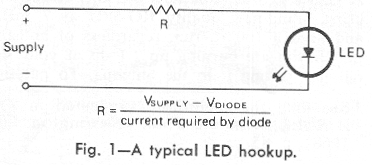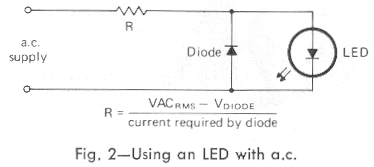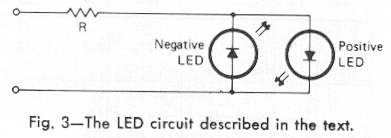Over the past several months we have received several letters from readers of this column asking for a "practical review" in the application of light emitting diodes. As a result, we will devote this monthly column to the "care and feeding" of these devices.
The light emitting diode (or LED as it is commonly called) is electrically, nothing more than a specially fabricated diode and therefore exhibits all diode characteristics. Where it differs from a conventional diode however, is when it is forward biased. At this time, it emits light which, with todays units can be either red, green, yellow or invisible (to the eye) infra-red depending on the semiconductor materials used in the fabrication of the particular device. The general design procedure for the use of any of the four varieties is the same however.
 Fig. 1 is a schematic of the basic LED circuit. Because of the
fact that the lED is a forward biased diode, a resistor is
necessary to limit current flow to a safe value.
Fig. 1 is a schematic of the basic LED circuit. Because of the
fact that the lED is a forward biased diode, a resistor is
necessary to limit current flow to a safe value.
Brightness is proportional to the current flowing through the LED but, like a conventional diode, too much current can damage the device. A little simple arithmetic is all that is necessary however to determine the value of the current limiting resistor. All of the necessary parameters for the formula in Fig. 1 (maximum current and diode forward voltage drop) can be obtained from the data sheet for the particular LED to be used. Typical figures incidentally are 1.5 volts for the diode forward drop and 20-30 milliamperes for the maximum current. When used as a pilot light indicator therefore, it is easy to see that the total power required for a LED and resistor (Vsupply × Idiode) is much less than that required for a conventional pilot lamp. As an example of this consider the case of the popular #47 lamp which requires 150 milliamperes at 6.3 volts, almost 1 watt. An LED used for this purpose, operating from the same 6.3 volts, would only require 20 milliamperes - a power of .126 watts or roughly 10 times less. Also, since the LED is a semiconductor device, its ruggedness and life will be many times that of the pilot lamp. In fact the only drawback is the amount of light output from the device which is less, but still completely adequate for almost all indicator requirements.
 One can also use a LED with a.c. in the same circuit as Fig. 1.
Here, the positive half cycle of the a.c. will act as the forward
biasing voltage while the negative half cycle will simply reverse
bias the diode and cut it off. The resulting 60 Hz flicker is not
noticeable by the eye and the final result seems the same. Care
must be taken in this application however, to assure that the
reverse voltage breakdown level, which is quite low in many LED's
is not exceeded. In case this is a problem, it is only necessary
to add a low cost diode in parallel with the LED as shown in Fig. 2.
This diode will conduct in the reverse direction of the LED
thereby limiting its reverse voltage. Note that the RMS value of
the a.c. is used for the resistor calculation in this application.
One can also use a LED with a.c. in the same circuit as Fig. 1.
Here, the positive half cycle of the a.c. will act as the forward
biasing voltage while the negative half cycle will simply reverse
bias the diode and cut it off. The resulting 60 Hz flicker is not
noticeable by the eye and the final result seems the same. Care
must be taken in this application however, to assure that the
reverse voltage breakdown level, which is quite low in many LED's
is not exceeded. In case this is a problem, it is only necessary
to add a low cost diode in parallel with the LED as shown in Fig. 2.
This diode will conduct in the reverse direction of the LED
thereby limiting its reverse voltage. Note that the RMS value of
the a.c. is used for the resistor calculation in this application.
 The low current and polarity sensitive features of light emitting
diodes offers many interesting and unique possibilities for the
experimenter. Fig. 3 is an example of a typical circuit made
possible by these characteristics. Here the LED is used in several
ways. The first, exactly as shown, is as a simple polarity indicator.
Depending on the input polarity the diode that is forward biased will
light and the other will remain off. Putting a.c. into this circuit
will cause both diodes to light, therefore it can be used as an
a.c./d.c. detector. If the circuit is connected to the output of
a communications receiver however, it will serve as a zero-beat
detector when adjusting the internal calibration oscillator to WWV.
As the beat note decreases in frequency the speed at which the two
LED's switch on during positive and negative half cycles of the
beat frequency gets slower and slower until one can easily see the
individual LED's go on and off. When both LEDs stay off, the receiver
is at zero beat! This same application could also be used as a
visual c.w. indicator for those so inclined.
The low current and polarity sensitive features of light emitting
diodes offers many interesting and unique possibilities for the
experimenter. Fig. 3 is an example of a typical circuit made
possible by these characteristics. Here the LED is used in several
ways. The first, exactly as shown, is as a simple polarity indicator.
Depending on the input polarity the diode that is forward biased will
light and the other will remain off. Putting a.c. into this circuit
will cause both diodes to light, therefore it can be used as an
a.c./d.c. detector. If the circuit is connected to the output of
a communications receiver however, it will serve as a zero-beat
detector when adjusting the internal calibration oscillator to WWV.
As the beat note decreases in frequency the speed at which the two
LED's switch on during positive and negative half cycles of the
beat frequency gets slower and slower until one can easily see the
individual LED's go on and off. When both LEDs stay off, the receiver
is at zero beat! This same application could also be used as a
visual c.w. indicator for those so inclined.
In conclusion, the LED is an extremely unique and useful device, quite easy to work with and may solve some of those "unsolvable problems" we all see to have from time to time.